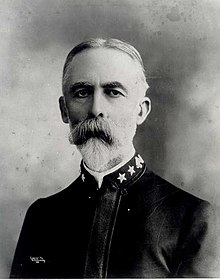William Thomas Sampson
| William Thomas Sampson | |
|---|---|

William Thomas Sampson
|
|
| Born |
February 9, 1840 Palmyra, New York, U.S. |
| Died | May 6, 1902 (aged 62) Washington, D.C., U.S. |
| Buried | Arlington National Cemetery, U.S. |
| Allegiance |
|
| Service/branch |
|
| Years of service | 1857–1902 |
| Rank |
|
| Commands held |
Alert Mayflower Swatara San Francisco Iowa North Atlantic Station |
| Battles/wars |
|
William Thomas Sampson (February 9, 1840 – May 6, 1902) was a United States Navy rear admiral known for his victory in the Battle of Santiago de Cuba during the Spanish–American War.
He was born in Palmyra, New York, and entered the United States Naval Academy on September 24, 1857. After graduating first in his class four years later, he served as an instructor at the Academy, teaching physics. In 1864, he became the executive officer of the monitor Patapsco of the South Atlantic Blockading Squadron and engaged in sweeping torpedoes off Charleston, South Carolina. He survived the loss of that ironclad on January 15, 1865, when she struck a torpedo, exploded, and sank with a loss of 75 lives.
Following duty in the steam frigate Colorado on the European Station, another tour as instructor at the Naval Academy, and in the Bureau of Navigation of the Navy Department, he served in the screw sloop Congress. He then commanded the Alert, the training ship Mayflower, and the Swatara while on duty at the Naval Academy.
...
Wikipedia
